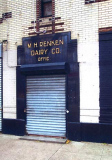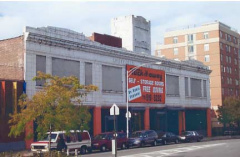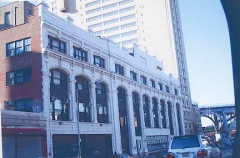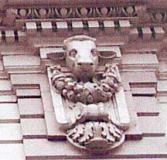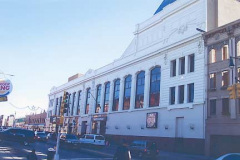Before modern efficiencies, milk and milk products were done on a local scale. Eventually due to New York City’s swelling population, larger facilities were needed. There were many private companies filling that demand, but by 1930 three dairy companies dominated the dairy scene. They were the United States Dairy Products Corp., Borden’s and Sheffield Farms. Most of those facilities are gone now, but a few buildings have survived…
R.H. Renken Dairy at SW corner of Classon & Myrtle Avenues, Clinton Hill Brooklyn. Building is unused presently. It was constructed in the 1930s by Koch & Wagner.
RIGHT: Art Deco design of office entrance on Myrtle Avenue side of building that’s still in good condition except for the missing “e” in office.
The M.H. Renken Dairy of Brooklyn, NY was established in 1927 in the eastern part of the borough, continuing operation until 1962.
Sheffield Farms, a major milk distributor in the Northeast in the late 1800s and early 1900s, was acquired by National Dairy Products (now Kraft, Inc.) in 1925. It has left a number of impressive buildings around town, not least what is now the CBS Broadcast Center at 524 West 57th Street at the northern end of Hell’s Kitchen. Here are some others…–your webmaster
Sheffield Farms on west side Webster Avenue between East 165th and 166th Streets in the Morrisania section of the Bronx. There was more of the dairy building on right side. That part was demolished to make way for the apartment building about ten years ago. (I know this personally because I used to drive the BX41 that went right past the building.)
Built between 1914-1921 by Frank Rooke.–your webmaster
A Sheffield Farms building on West 125th Street between Broadway and 12th Avenue is now Prentis Hall, Department of Chemical Engineering; it was constructed in 1906 with the architect being Edgar Moeller.
Sheffield Farms in Brooklyn. This facility was on south side of Fulton Street between Brooklyn & New York Avenues. The building was transformed to The Restoration Center in the early 1970s. The Restoration center contains retail stores that includes a Duane-Reade drugstore, Baskin-Robbins, a branch of Citibank, a supermarket that was formerly Pathmark, a skating rink and the Billie Holiday Theater where off-off Broadway shows are presented.
Mayflower Ice Cream Company on east side of Vernon Avenue near 43rd Avenue in Long Island City,Queens.
RIGHT: The former W.M. Evans Dairy Co. on Fulton Street and Eldert Lane in Cypress Hills, Brooklyn. This is the highest numbered address on Brooklyn’s Fulton Street–your webmaster
The history of Borden’s is a lengthy and illustrious one in the annals of American entrepreneurship.
From famoustexans.com:
As an American philanthropist, businessman, and inventor, Gail Borden, Jr. envisioned food concentrates as a means of safeguarding the human food supply. He was the first to develop a commercial method of condensing milk, and the dairy company founded by him (renamed Borden, Inc., in 1968) expanded and diversified to become a sizable corporation operating in many areas of business.
Gail Borden, Jr., (1801-1874) inventor, publisher, surveyor, and founder of the Borden Company, son of Gail and Philadelphia Borden, was born in Norwich, New York, on November 9, 1801. In the middle 1840s he began inventing. He is supposed to have experimented with large-scale refrigeration as a means of preventing yellow fever and with a terraqueous machine, a sort of prairie schooner that would go on land or water. In 1849 he perfected a meat biscuit, made of dehydrated meat compounded with flour, which he tried to market on a worldwide scale in partnership with Ashbel Smith. Although this project left him deeply in debt, for seven years Borden struggled to sell meat biscuits. For this purpose he moved to New York in 1851 to be nearer trade centers.
In 1853 he sought a patent on a process for condensing milk in vacuum, but it was 1856 before he received American and British patents. He then dropped the meat biscuit to devote himself to condensing milk. He opened a factory in Connecticut in 1856 but failed, then tried and failed again in 1857. Through Jeremiah Milbank, a New York financier, he received new backing and opened another factory in Connecticut in 1858. When the Civil War brought intensified demand for condensed milk, sales grew so much that Borden’s success was assured. He opened another factory in Connecticut, two in New York, and one in Illinois and licensed other concerns in Pennsylvania and Maine. He also invented processes for condensing various fruit juices, for extract of beef, and for coffee. After the Civil War he established a meat-packing plant at Borden, Texas, twelve miles west of Columbus, and a sawmill and copperware factory at Bastrop.
He died in Borden, Texas, a community named for him. Today it boasts a population of about 50.
Borden mascot Elsie the Cow, her husband Elmer the Bull and calf Lobelia appeared in the 1930s, making an appearance at the Flushing Meadows World’s Fair, an event recollected in sidewalk mosaics there [see Forgotten Tour 19]
Elsie’s got a new look…check it out at Borden Products Online.
Borden is the most storied of the dairies shown here, and the remnants of Borden’s plants in NYC are likewise some of the more impressive of NYC’s defunct dairies…
I’m not Elsie. This is Borden’s facility on south side of Atlantic Avenue near Barbey Street in East New York, Brooklyn.
The blue terra cotta Borden’s entablature is cracked and broken above what was the main entrance, but flanking the door are two of NYC’s more unsung terra cotta designs, seemingly depicting Switzerland.
While New York is full of gorgeous terra cotta,some of it gets no respect: the large tablet at theTunnel Garage has now disappeared as the gragae is demolished, and several wonderful scenes depicting activities at Seaview Hospital lie cracked, broken, and overgrown with weeds and fungus.
Happily, Parkchester in the Bronx has dozens of terrific pieces still. —your webmaster
This Borden’s facility is on the east side of Ralph Avenue between Monroe Street and Gates Avenue in Bedford-Stuyvesant, Brooklyn, and its identifying tablet is still there.
erpietri@earthlink.net
Photographed mid-to-late 2005 by Gary Fonville. Page completed April 8, 2006.


